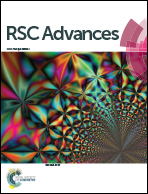Pressure-induced phase transition in hydrogen-bonded molecular crystal acetamide: combined Raman scattering and X-ray diffraction study†
Abstract
The structural and vibrational properties of acetamide under high pressure were probed by in situ synchrotron X-ray diffraction (XRD) and Raman scattering up to ∼10 GPa. Two structural phase transitions are observed at 0.9 and 3.2 GPa, evidenced by the obvious changes in the Raman spectra as well as the discontinuities of peak positions versus pressure. The phase transitions are further confirmed by the significant changes in the XRD patterns. The two phase transitions are proposed to originate from the rearrangements of hydrogen-bonded networks, deduced by the redistribution of intensities and positions of N–H vibrations. Detailed analysis of the XRD patterns indicates that the first high-pressure phase (phase II) possesses a monoclinic structure with a possible space group of C2/c. Moreover, the phase transitions are reversible since the diffraction pattern returns to its initial state upon total decompression. The detailed mechanisms for these phase transitions, the cooperativity of different intermolecular interactions, as well as the high-pressure behaviors of hydrogen bonds are presented and discussed.


 Please wait while we load your content...
Please wait while we load your content...